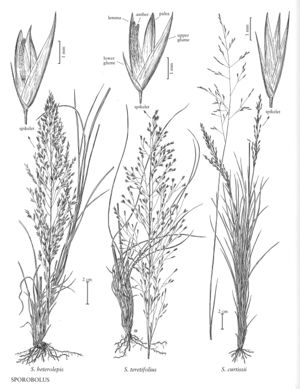Sporobolus teretifolius
Plants perennial; cespitose, not rhizomatous. Culms (20)35-80(100) cm, wiry. Sheaths shiny and indurate basally, glabrous or appressed hairy elsewhere, hairs to 4 mm; ligules 0.2-0.4 mm; blades (10)25-54 cm long, 0.5-1.2 mm wide, terete or subterete at least basally, sometimes channeled for portions of their length, green to yellowish-green, senescing or turning tan in late fall, glabrous on both surfaces or the adaxial surface sparsely hairy basally, margins smooth. Panicles 10-26 cm long, 1-9 cm wide, open (contracted when immature), not diffuse, narrowly pyramidal to ovate; lower nodes with 1-2(3) branches; primary branches 1-8 cm, ascending or spreading to 40° from the rachis, not capillary, without spikelets on the lower 1/3; secondary branches spreading; pulvini hairy; pedicels 3-18 mm, longer than the spikelets, spreading, with scattered ascending hairs. Spikelets 4-5.6 mm, purplish-brown. Glumes unequal, linear-lanceolate, membranous; lower glumes 2-3.8 mm, 0.5-0.8 times as long as the upper glumes; upper glumes 4-5.6 mm, usually longer than the florets; lemmas 3.4-4.4 mm, ovate, membranous, glabrous, acute; paleas 3.3-4.4 mm, ovate, membranous, glabrous; anthers 1.5-2.6 mm, purplish. Fruits not seen. 2n = unknown.
Distribution
N.C., S.C., Fla., Ala., Ga.
Discussion
Sporobolus teretifolius is restricted to the south¬eastern United States, where it grows in wet to moist flatwoods and savannahs, at elevations of 10-150 m.
Selected References
None.
